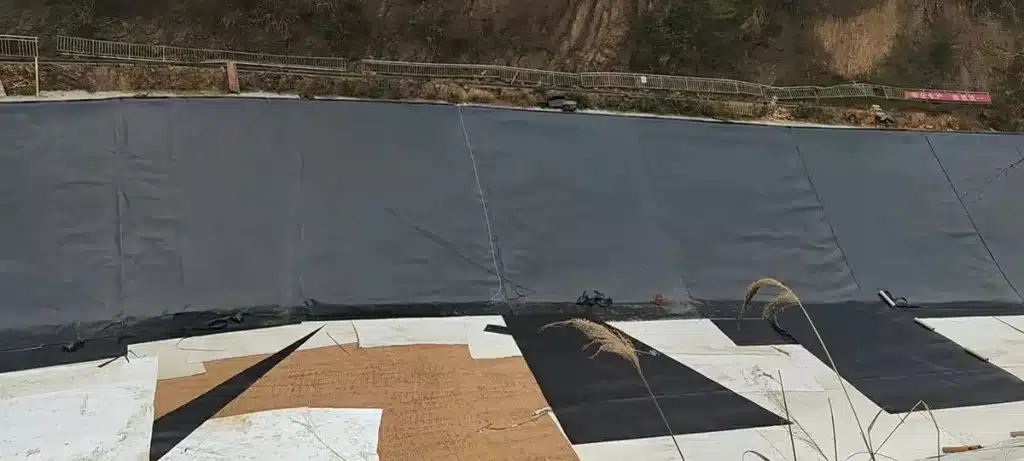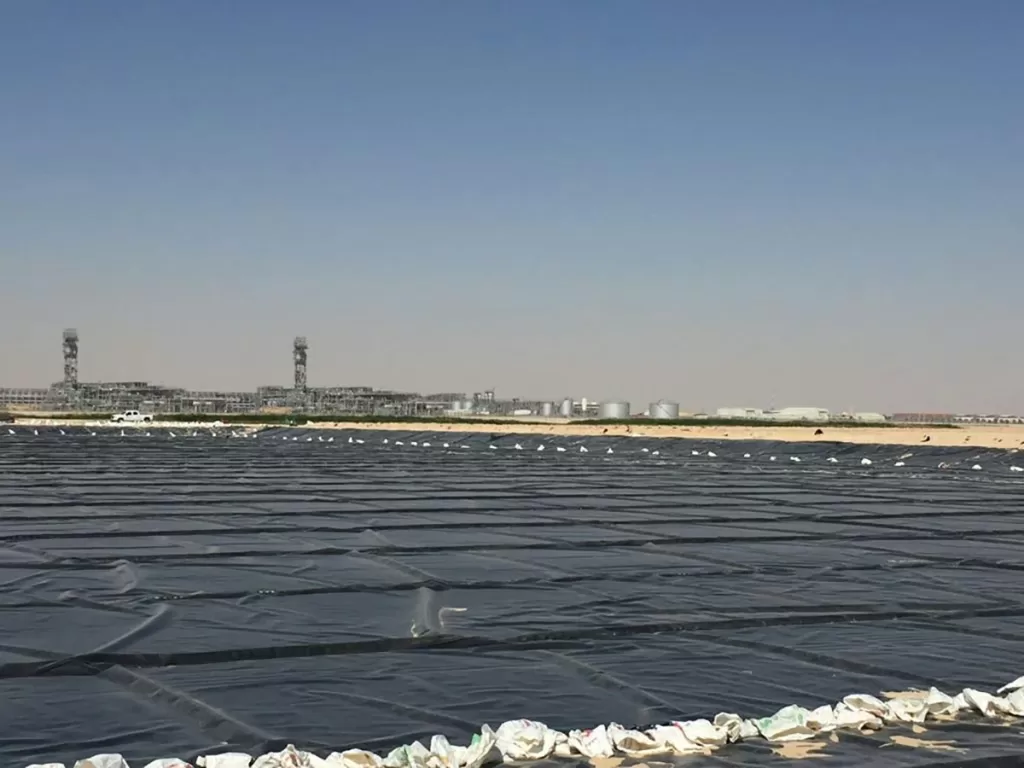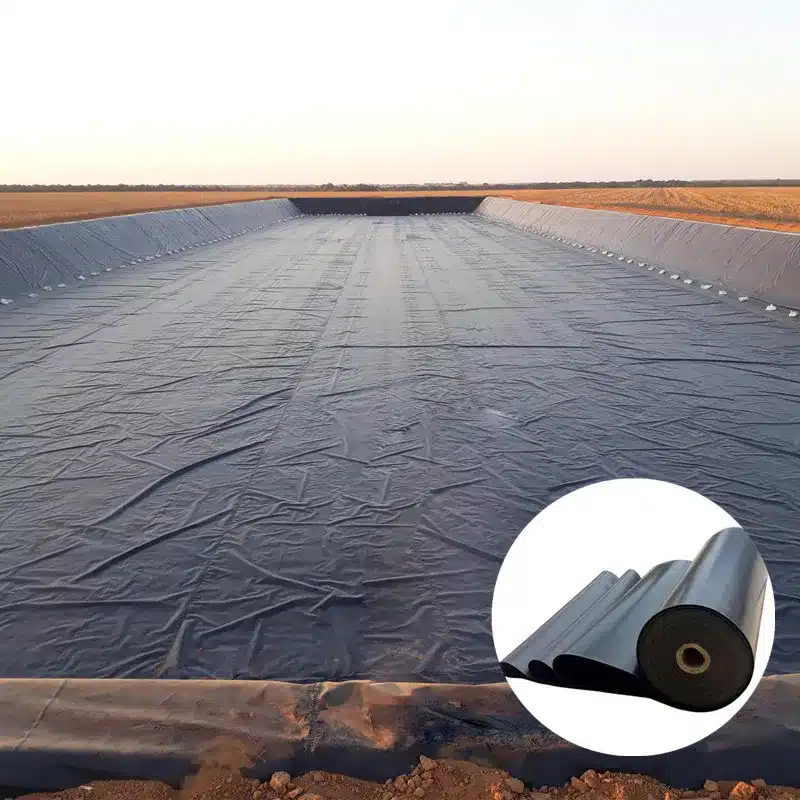+86-159 9860 6917
info@geofantex.com
geofantex@gmail.com
+86-400-8266163-44899
A geomembrane is a synthetic liner or barrier with extremely low permeability, used alongside various geotechnical materials to control the migration of fluids in engineered projects. Its primary purpose is to restrict fluid movement and ensure safe containment in applications ranging from landfills to industrial facilities. For detailed product options, see Geomembrane solutions.
Applications of Geomembranes:
- Landfills: Geomembranes act as liners or caps, preventing leachate from contaminating soil and groundwater. They create a robust barrier to ensure safe waste containment. Learn more at Landfill geomembrane solutions.
- Mining: Used in tailings ponds and heap leach facilities, geomembranes contain hazardous chemicals, preventing environmental contamination. Visit Mining containment solutions.
- Ponds and Reservoirs: Geomembranes line ponds, reservoirs, and artificial lakes, reducing seepage and water loss. They are essential for water conservation and agricultural irrigation. See Pond liner solutions.
- Wastewater Treatment: In treatment facilities, geomembranes form secondary containment structures and lagoons, ensuring hazardous materials are safely confined. More info at Wastewater containment.
Advantages of Geomembranes:
- Impermeability: Provides a barrier that effectively prevents liquid and gas migration.
- Durability: Resistant to UV, extreme temperatures, and chemical exposure.
- Cost-Effective: Reduces excavation and construction costs compared to traditional methods.
- Environmental Protection: Isolates hazardous materials, safeguarding ecosystems.
- Versatility: Customizable for various project requirements.
- Rapid Installation: Faster and less disruptive than conventional construction.
For further applications, explore Geomembrane product benefits.

What is a geomembrane and why is it used?
A geomembrane is a synthetic liner or barrier with extremely low permeability, designed to control fluid migration in engineered projects. Its main function is to restrict liquid and gas movement, ensuring safe containment and environmental protection. Key features include:
- Impermeability: Prevents leachate, wastewater, or hazardous fluids from contaminating soil and groundwater.
- Durability: Resistant to UV exposure, extreme temperatures, and chemical attack.
- Versatility: Suitable for landfills, mining, ponds, reservoirs, wastewater treatment, and other containment applications.
- Cost-Effectiveness: Reduces excavation and construction costs compared to traditional containment methods.
- Environmental Protection: Safeguards ecosystems by isolating hazardous materials.
- Rapid Installation: Easier and faster to deploy than conventional liners.
Geomembranes are widely applied in landfills, tailings ponds, industrial containment, and water reservoirs, providing a reliable solution for fluid management and long-term project safety. For a full range of products and applications, see Geomembrane solutions.

What factors affect the lifespan of a geomembrane?
- Material Type: HDPE offers the longest life; PVC and EPDM may degrade faster.
- UV Exposure: Proper coverage or UV-stabilized membranes extend service life.
- Chemical Environment: Compatibility with acids, alkalis, and hydrocarbons is crucial.
- Temperature Fluctuations: Extreme heat or cold can cause expansion or cracking.
- Installation Quality: Proper welding and surface preparation prevent premature failure.
- Maintenance and Protection: Regular inspections, repairs, and protective layers improve durability.
With proper selection and installation, HDPE geomembranes can last over 50 years, providing long-term containment and environmental safety. For more, visit Geomembrane durability guide.
How thick should a geomembrane be for different applications?
The appropriate thickness of a geomembrane depends on the type of project, regulatory requirements, and environmental conditions:
- Landfill Primary Liner: Typically 60 mils (1.5 mm) to provide a robust barrier against leachate.
- Secondary Liner: Usually 40–60 mils (1.0–1.5 mm) to serve as additional containment.
- Final Cover or Cap: Commonly 40–60 mils (1.0–1.5 mm) for protective surface layers.
- Hazardous Waste Landfill: Recommended 80 mils (2.0 mm) or more for enhanced chemical resistance.
- Other Applications (Ponds, Reservoirs, Tailings): Thickness may range from 30–60 mils (0.75–1.5 mm) depending on hydrostatic pressure, soil conditions, and load requirements.
Key Considerations:
- Always comply with local regulations and engineering standards for geomembrane thickness.
- Consider chemical exposure, UV stability, and mechanical stresses when selecting thickness.
- Proper installation, protective layers, and maintenance extend service life, with HDPE geomembranes lasting 50+ years in optimal conditions.
Selecting the correct geomembrane thickness ensures long-term containment, environmental safety, and durability for any engineered project.
Geomembranes are essential in projects where preventing material loss is critical, including water, wastewater, vapor, soil, and hazardous substances. Proper design, installation, and maintenance allow industries to safely manage fluids and execute projects at larger scales than previously possible. For additional geomembrane applications and guides, visit Geofantex.



Get Free Sample
We’ll respond as soon as possible(within 12 hours)





















